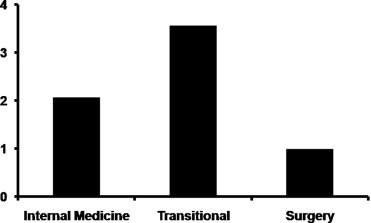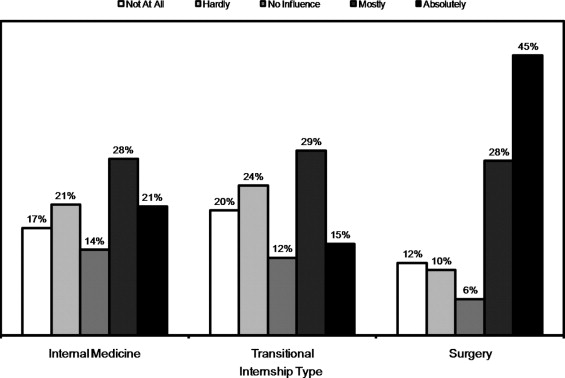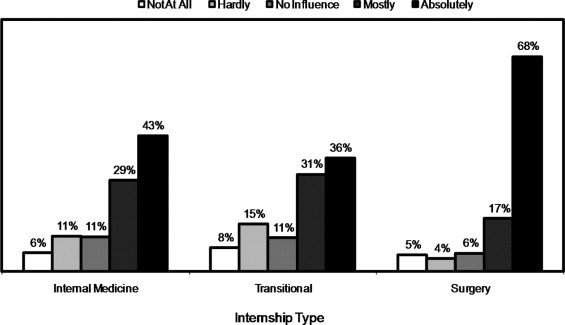Rationale and Objectives
The purposes of the study were to determine (a) if radiology residents and fellows view their internship year as a valued prerequisite for their career as a radiologist and as a physician, (b) how their postgraduate year (PGY)-1 was perceived with regard to a specific type of internship (i.e., internal medicine, transitional year, or surgery), and (c) how their internship is considered from the vantage point of their current year of training and subspecialty career choice.
Materials and Methods
A survey was sent to all current U.S. radiology residents and fellows from a list derived from the American College of Radiology database. They were polled regarding their experiences in their preliminary year (PGY-1). Responses were coded on a 5-point Likert scale.
Results
Response rate for the study was 35%. Although 70% of respondents maintained that their internship year was necessary for their development as a physician, only 49% indicated that it was necessary for their development as a radiologist. Of respondents who graduated from surgical internships, 72% claimed that their PGY-1 was important for their development as a radiologist, compared to 44% of former transitional year interns and 49% of internal medicine interns ( P < .001). When disaggregated by subspecialty career choice, participants were evenly divided about their perceptions of their intern year. However, among those considering interventional radiology, 67% of respondents considered their internship important to their development as a radiologist ( P < .001).
Conclusion
Overall, these data suggest that although the internship year was believed to have merit, the transitional year was least liked by radiology trainees. Efforts should be made to determine why the transitional year does not fare so well in the hope that structural improvements in it can be undertaken to make the year seem more worthwhile and more highly regarded.
A mandated pre-radiology clinical year had been a long-time residency requirement until it was eliminated in 1971 by the American Board of Radiology. Over the next 26 years, the importance of the internship became a subject of continual controversy, engaging the attention of program directors, chairs of radiology, and the trainees themselves. The debate increased in intensity just before the reimposition of the internship in 1997 as a preliminary obligation preceding the pursuit of residency training (personal communication American Board of Radiology [ABR], Debra Weitzell, ABR historian). Since then, the value of the internship has remained a matter of discussion ( ). Opinions on the subject have varied greatly but tend to aggregate toward opposing poles—some regard an interval of direct clinical care as integral to their development as a physician and specifically as a radiologist ( ), whereas others deem the internship to be largely irrelevant to the accumulation of professional acumen pertinent for imaging specialists ( ). The diversity of views applies also to particular issues related to professional interactions, procedural expertise, and even the management of debt engendered by the preliminary year ( ). Although those matters have been considered in a variety of forums, the perceptions of residents and fellows looking backward on their internship experiences has not been previously examined. In this survey, we endeavored to query all current residents and fellows about aspects of their internship to determine if an overall consensus exists about it and if particular differences can be discerned from the responses from distinct groups of trainees, disaggregated by type of internship, current training year, and subspecialty expectation.
The purposes of the study were to determine: (a) whether radiology residents and fellows view their internship year as a valued prerequisite for their career as a radiologist and as a physician; (b) how their postgraduate year (PGY)-1 was perceived with regard to a specific type of internship (i.e., internal medicine [IM], transitional year, or surgery); and (c) how their internship is considered from the vantage point of their current year of training and subspecialty career choice.
Materials and methods
Get Radiology Tree app to read full this article<
Get Radiology Tree app to read full this article<
Get Radiology Tree app to read full this article<
Results
Get Radiology Tree app to read full this article<
Get Radiology Tree app to read full this article<
Get Radiology Tree app to read full this article<
Get Radiology Tree app to read full this article<
Get Radiology Tree app to read full this article<
Get Radiology Tree app to read full this article<
Get Radiology Tree app to read full this article<
Get Radiology Tree app to read full this article<
Get Radiology Tree app to read full this article<
Table 1
Respondents’ View of the Value of Internship for Their Development as a Radiologist Disaggregated by Subspecialty Career Choice
Not at All Hardly No Influence Mostly Absolutely Total No. of Respondents General radiology 20% 19% 14% 28% 19% 168 Musculoskeletal 25% 27% 9% 21% 18% 340 Body imaging 16% 22% 12% 29% 21% 387 Women’s imaging 14% 22% 14% 30% 20% 148 Interventional radiology 12% 14% 8% 30% 37% 273 Total No. of responses 18% 21% 11% 27% 23% 1316
Get Radiology Tree app to read full this article<
Get Radiology Tree app to read full this article<
Table 2
Respondents’ View on the Value of Internship for Their Development as a Radiologist Disaggregated by Year of Postgraduate (PGY) Training
Not at All Hardly No Influence Mostly Absolutely Total No. of Respondents PGY-2 17% 23% 13% 29% 18% 353 PGY-3 19% 20% 11% 28% 22% 374 PGY-4 19% 22% 10% 28% 20% 358 PGY-5 20% 25% 15% 25% 15% 308 Fellows 16% 18% 12% 31% 24% 520 Total No. of Responses 18% 21% 12% 28% 20% 1913
Get Radiology Tree app to read full this article<
Get Radiology Tree app to read full this article<
Get Radiology Tree app to read full this article<
Discussion
Get Radiology Tree app to read full this article<
Get Radiology Tree app to read full this article<
Get Radiology Tree app to read full this article<
Get Radiology Tree app to read full this article<
Get Radiology Tree app to read full this article<
Get Radiology Tree app to read full this article<
Get Radiology Tree app to read full this article<
References
1. Ellis J.H., Vydareny K.H., Bookstein F.L., et. al.: Impact of pre-radiology clinical years on resident performance. Invest Radiol 1989; 24: pp. 568-574.
2. Ravin C.E.: The case for a clinical year prior to radiology residency. Invest Radiol 1986; 21: pp. 287-288.
3. Sartoris D.J.: A clinical year for radiology trainees: Necessary or detrimental?. AJR Am J Roentgenol 1987; 148: pp. 652-653.
4. Cuttino J.T.: First year radiology residents: PG I vs PG II. AJR Am J Roentgenol 1979; 132: pp. 855-856.
5. Gay S.B., Hillman B.J., McNulty B.C., Altmaier E.M., Smith W.L.: Effect of preradiology clinical training on the performance of radiology residents. Invest Radiol 1993; 28: pp. 1090-1094.


